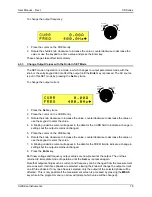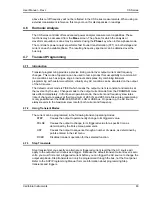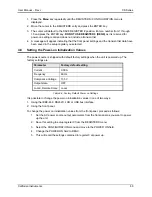
User Manual – Rev J
CS Series
California Instruments
83
above this cutoff frequency will not be reflected in the CS Series measurements. When using an
external measurement reference, this may account for discrepancies in readings.
4.6 Harmonic
Analysis
The CS Series controller offers advanced power analyzer measurement capabilities. These
functions may be accessed from the
Meas
screen. The phase for which the analysis or
waveform acquisition is done may be selected using the
Phase
key when in three-phase mode.
The controller’s power analyzer performs fast Fourier transformation (FFT) on both voltage and
current on each available phase. The resulting frequency spectrum can be obtained over the
bus only.
4.7 Transient
Programming
4.7.1 Introduction
Transient programming provides a precise timing control over output current and frequency
changes. This mode of operation can be used to test a product for susceptibility to common AC
line conditions such as surges, sags, brownouts and spikes. By combining transient
programming with custom waveforms, virtually any AC condition can be simulated on the output
of the AC source.
The default current mode is FIXED which means the output current is constant and remains at
the level set by the user. Changes made to the output current made from the PROGRAM menu
take effect immediately. In front panel operation mode, the current and frequency slew rates
(rate of change) are always at their maximum of 2E5 V/s and 2E5 Hz/s. Slew rate programming
is only possible over the IEEE-488, RS232C, LAN or USB bus. On power up, the AC source
always reverts to the maximum slew rate for both current and frequency.
4.7.2
Using Transient Modes
The current can be programmed in the following transient operating modes:
STEP
Causes the output to permanently change to its triggered value.
PULSE
Causes the output to change to its triggered value for a specific time, as
determined by the Pulse menu parameters.
LIST
Causes the output to sequence through a number of values, as determined by
points entered in the List menu.
FIXED
Disables transient operation for the selected function.
4.7.3 Step
Transients
Step transients let you specify an alternate or triggered current level that the AC source will
apply to the output when it receives a trigger. Because the default transient current level is zero
volts, you must first enter a triggered current before you can trigger the AC source to change the
output amplitude. Step transients can only be programmed through the bus, not the front panel.
Refer to the SCPI Programming Manual for more information about programming Step
transients and triggers.
Содержание 13500CS/3
Страница 5: ...User Manual Rev J CS Series California Instruments 5 SAFETY SYMBOLS ...
Страница 34: ...User Manual Rev J CS Series California Instruments 34 Figure 3 3 9000CS 2 Wiring diagram 3 Phase mode ...
Страница 35: ...User Manual Rev J CS Series California Instruments 35 Figure 3 4 13500CS 3 Wiring diagram 3 Phase mode ...
Страница 36: ...User Manual Rev J CS Series California Instruments 36 Figure 3 5 18000CS 4 Wiring diagram 3 Phase mode ...
Страница 56: ...User Manual Rev J CS Series California Instruments 56 The power source is now ready to be used ...
Страница 73: ...User Manual Rev J CS Series California Instruments 73 ...
Страница 111: ...User Manual Rev J CS Series CS Series 111 voltage rating 28 W Weight 22 Wiring AC input 30 ...






























